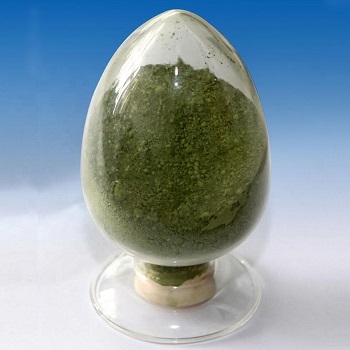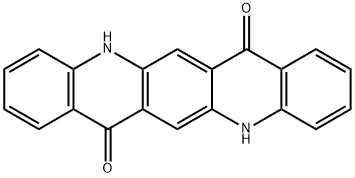Quinhydrone
Synonym(s):Hydroquinone: benzoquinone 1:1 complex;Quinhydrone
- CAS NO.:106-34-3
- Empirical Formula: C12H10O4
- Molecular Weight: 218.21
- MDL number: MFCD00010310
- EINECS: 203-387-6
- SAFETY DATA SHEET (SDS)
- Update Date: 2025-01-27 09:38:02

What is Quinhydrone?
Chemical properties
a dark green crystalline powder which is a complex formed by benzoquinone and hydroquinone.

Quinhydrone is a general reagent used in potentiometric titrations. It can also be used as a π-acceptor in the formation of charge-transfer complex of analytes for spectrophotometric analysis.
Definition
ChEBI: Quinhydrone is an addition compound. It contains a 1,4-benzoquinone and a hydroquinone.
Definition
The so-called quinhydrone electrode, containing equivalent amounts of p-benzoquinone and hydroquinone, is used to determine hydrogen ion concentrations of unknown solutions. Hydroquinone is used principally as a photographic developing agent. The main advantages of the quinhydrone electrode are low internal resistance, rapid response, high accuracy, simplicity, free of errors due to the presence of nonreducing gases, and free of salt errors. Major limitations are that it contaminates the solution, cannot be used to monitor a flowing solution, the solution must be free of strong oxidizing and reducing agents, and it is limited to a pH range of 1 to 9. In alkaline solution, the weakly acidic H2Q is neutralized and is subject to oxidation by air and dissolved oxygen. The main application of the quinhydrone electrode is in nonaqueous solvents where reproducible results are obtained in a variety of solvents. The tetra-chloro derivative (chloranil electrode) is even more useful.
General Description
Quinhydrone/methanol treatment for the measurement of carrier lifetime in crystalline silicon substrates has been reported. Surface passivation of silicon substrates by quinhydrone/ethanol treatment has been investigated.
Description
Quinhydrone is a molecular species composed of one p-quinone(Q) and one p-hydroquinone(H2Q) held together by hydrogen bonding.
The Uses of Quinhydrone
The quinhydrone method may be used for determining PH on solid medium, such as agar, Petroff's medium, egg medium or any other solid medium when there are no secondary oxidation or reduction reactions.
Properties of Quinhydrone
| Melting point: | 167-172 °C (lit.) |
| Boiling point: | 285 °C |
| Density | 1.32 |
| refractive index | 1.4270 (estimate) |
| storage temp. | Store below +30°C. |
| solubility | 4g/l |
| form | Crystalline Powder |
| Specific Gravity | 0.863 (20/4℃) |
| color | Dark green |
| Water Solubility | 4 g/L (20 ºC) |
| Sensitive | Light Sensitive |
| Merck | 14,8058 |
| BRN | 3919222 |
| Stability: | Stable. Incompatible with strong oxidizing agents. |
| CAS DataBase Reference | 106-34-3(CAS DataBase Reference) |
| NIST Chemistry Reference | Quinhydrone(106-34-3) |
| EPA Substance Registry System | Quinhydrone (106-34-3) |
Safety information for Quinhydrone
| Signal word | Danger |
| Pictogram(s) |
 Skull and Crossbones Acute Toxicity GHS06  Environment GHS09 |
| GHS Hazard Statements |
H301:Acute toxicity,oral H400:Hazardous to the aquatic environment, acute hazard |
| Precautionary Statement Codes |
P264:Wash hands thoroughly after handling. P264:Wash skin thouroughly after handling. P270:Do not eat, drink or smoke when using this product. P273:Avoid release to the environment. P391:Collect spillage. Hazardous to the aquatic environment P301+P310:IF SWALLOWED: Immediately call a POISON CENTER or doctor/physician. P405:Store locked up. |
Computed Descriptors for Quinhydrone
New Products
4,4-Difluoropiperidine hydrochloride tert-butyl 9-methoxy-3-azaspiro[5.5]undecane-3-carboxylate Indole Methyl Resin N-Isopropylurea N,N-Dicyclohexylcarbodiimide(DCC) MELDRUMS ACID 5-METHYLISOXAZOLE-4-CARBOXYLIC ACID Magnessium Bis glycinate Zinc ascorbate 1-bromo-2-butyne 2-acetamidophenol 9(10H)-anthracenone Erythrosin B, 4-Piperidinopiperidine 2-((4-morpholinophenylamino) (methylthio) methylene) malononitrile 2,4-dihydroxybenzaldehyde 3-(4-morpholinophenylamino)-5-amino-1H-pyrazole-4-carbonitrile Methyl 2-methylquinoline-6-carboxylate 2,6-dichloro-4-nitropyridine 4-Bromo-2-chlorobenzonitrile 2-(benzylamino)acetic acid hydrochloride 4-(tert-Butoxycarbonylamino)but- 2-ynoic acid 3,4-dihydro-2H-benzo[b][1,4]dioxepine 1-Phenyl-1-cycloprppanecarboxylicacidRelated products of tetrahydrofuran








You may like
-
 Quinhydrone CAS 106-34-3View Details
Quinhydrone CAS 106-34-3View Details
106-34-3 -
 Quinhydrone 98.00% CAS 106-34-3View Details
Quinhydrone 98.00% CAS 106-34-3View Details
106-34-3 -
 Quinhydrone CAS 106-34-3View Details
Quinhydrone CAS 106-34-3View Details
106-34-3 -
 Quinhydrone, GR 97% CAS 106-34-3View Details
Quinhydrone, GR 97% CAS 106-34-3View Details
106-34-3 -
 QUINHYDRONE AR CAS 106-34-3View Details
QUINHYDRONE AR CAS 106-34-3View Details
106-34-3 -
 Quinhydrone CAS 106-34-3View Details
Quinhydrone CAS 106-34-3View Details
106-34-3 -
 20677-73-0 (2,2-diethoxyethyl)methylamine 98%View Details
20677-73-0 (2,2-diethoxyethyl)methylamine 98%View Details
20677-73-0 -
 3-(4-(hydroxyamino)-1-oxoisoindolin-2-yl)piperidine-2,6-dione 98%View Details
3-(4-(hydroxyamino)-1-oxoisoindolin-2-yl)piperidine-2,6-dione 98%View Details
